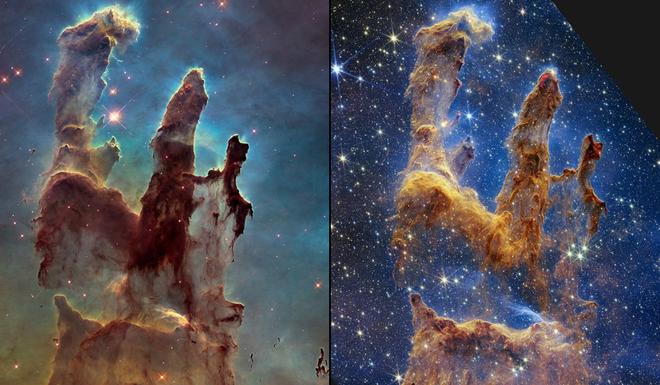Published 11:05 IST, May 19th 2024
Beyond The Visible: Nasa's Infrared View Unveils Secrets Of Starbirth In The ‘Pillars Of Creation’
NASA's new images of the Pillars of Creation reveal star formation within the Eagle Nebula using visible and near-infrared light.

NASA has recently released breathtaking images of the iconic ‘Pillars of Creation’ located within the Eagle Nebula. These towering structures, home to billions of newborn stars, stretch several light-years in length and are situated approximately 7,000 light-years away from Earth in the direction of the constellation Serpens.
The U.S. space agency shared two distinct images of the ‘Pillars of Creation’. The first image, captured in visible light, and the second, taken by the NASA Hubble telescope in low-infrared light, provide a mesmerizing view of this stellar nursery.
Check out the post:
NASA wrote in their post, “@NASAHubble captured this iconic view of the Pillars of Creation, showing off towers that stretch light-years in length, around 7,000 light-years away from Earth in the direction of the constellation Serpens. The Pillars of Creation are part of an active star-forming region within the Eagle Nebula, hiding newborn stars in the columns of dust and gas. In this image captured in visible light, blue represents oxygen, red sulfur, and green is both nitrogen and hydrogen.”
What are the Pillars of Creation?
According to NASA, "the Pillars of Creation are part of an active star-forming region within the Eagle Nebula, hiding newborn stars in the columns of dust and gas." These magnificent pillars are composed of cool molecular hydrogen and dust, which are gradually being eroded by the intense ultraviolet light from nearby hot stars.

In NASA's visible light image, different colors represent various elements: blue stands for oxygen, red indicates sulfur, and green represents both nitrogen and hydrogen. This color-coded representation helps scientists understand the composition and processes occurring within these celestial columns.
The second image, captured in near-infrared light, offers a different perspective, aiding researchers in refining their theories on star formation in nebulae. By observing the phenomenon at various wavelengths, scientists can obtain a more accurate count of the stars concealed within and beneath the pillars. This image reveals the semi-opaque and rusty-red hues of the Pillars of Creation, with the second and third pillars appearing in darker shades of brown and red outlines.

“Two images are shown of the Pillars of Creation, a star-forming region in space. The first one is Hubble’s visible-light view, which shows darker pillars that rise from the bottom to the top of the screen, ending in three points. The background is opaque, set off in yellow and green toward the bottom and blue and purple at the top. A handful of stars of various sizes appear," NASA explained in their Instagram post.
These awe-inspiring images not only showcase the beauty of the cosmos but also enhance our understanding of the complex processes involved in star formation. By continuing to explore and capture the wonders of our universe, NASA provides invaluable insights into the mysteries of space.
Updated 11:05 IST, May 19th 2024


